 W
WThe Boeing B-29 Superfortress is an American four-engined propeller-driven heavy bomber designed by Boeing and flown primarily by the United States during World War II and the Korean War. Named in allusion to its predecessor, the B-17 Flying Fortress, the Superfortress was designed for high-altitude strategic bombing but also excelled in low-altitude night incendiary bombing and in dropping naval mines to blockade Japan. B-29s dropped the atomic bombs on Hiroshima and Nagasaki and became the only aircraft that has ever used nuclear weapons in combat.
 W
WThe XB-38 Flying Fortress was a single example conversion of a production B-17E Flying Fortress, testing whether the Allison V-1710 V type engine could be substituted for the standard Wright R-1820 radial engine during early World War II.
 W
WThe Boeing XB-39 Superfortress was a United States prototype bomber aircraft, a single example of the B-29 Superfortress converted to fly with alternative powerplants. It was intended to demonstrate that the B-29 could still be put into service even if the first choice of engine, the air-cooled Wright R-3350 radial engine, ran into development or production difficulties.
 W
WThe Boeing YB-40 Flying Fortress was a modification for operational testing purposes of the B-17 Flying Fortress bomber aircraft, converted to act as a heavily armed gunship to support other bombers during World War II. At the time of its development, long-range fighter aircraft such as the North American P-51 Mustang were just entering quantity production, and thus were not yet available to accompany bombers all the way from England to Germany and back.
 W
WThe Boeing B-47 Stratojet is a retired American long-range, six-engined, turbojet-powered strategic bomber designed to fly at high subsonic speed and at high altitude to avoid enemy interceptor aircraft. The primary mission of the B-47 was as a nuclear bomber capable of striking targets within the Soviet Union.
 W
WThe Boeing B-50 Superfortress is an American strategic bomber. A post–World War II revision of the Boeing B-29 Superfortress, it was fitted with more powerful Pratt & Whitney R-4360 radial engines, stronger structure, a taller tail fin, and other improvements. It was the last piston-engined bomber built by Boeing for the United States Air Force, and was further refined into Boeing's final such design, the B-54. Though not as well known as its direct predecessor, the B-50 was in USAF service for nearly 20 years.
 W
WThe Consolidated B-32 Dominator was an American heavy strategic bomber built for United States Army Air Forces during World War II, which had the distinction of being the last Allied aircraft to be engaged in combat during World War II. It was developed by Consolidated Aircraft in parallel with the Boeing B-29 Superfortress as a fallback design should the B-29 prove unsuccessful. The B-32 only reached units in the Pacific during mid-1945, and subsequently saw only limited combat operations against Japanese targets before the end of the war. Most of the extant orders of the B-32 were canceled shortly thereafter and only 118 B-32 airframes of all types were built.
 W
WThe Consolidated XB-41 Liberator was a single Consolidated B-24D Liberator bomber, serial 41-11822, which was modified for the long-range escort role for U.S. Eighth Air Force bombing missions over Europe during World War II.
 W
WThe Consolidated TBY Sea Wolf was a United States Navy torpedo bomber of World War II. A competitor and contemporary to the Grumman TBF Avenger, the Sea Wolf was subject to substantial delays and never saw combat; only 180 of the type were built before cancellation after VJ Day.
 W
WThe Convair B-36 "Peacemaker" is a strategic bomber built by Convair and operated by the United States Air Force (USAF) from 1949 to 1959. The B-36 is the largest mass-produced piston-engined aircraft ever built. It had the longest wingspan of any combat aircraft ever built, at 230 ft (70 m). The B-36 was the first bomber capable of delivering any of the nuclear weapons in the U.S. arsenal from inside its four bomb bays without aircraft modifications. With a range of 10,000 mi (16,000 km) and a maximum payload of 87,200 lb (39,600 kg), the B-36 was capable of intercontinental flight without refuelling.
 W
WThe Convair XB-46 was a single example of an experimental medium jet bomber which was developed in the mid-1940s but which never saw production or active duty. It competed with similar designs, the North American XB-45 and Martin XB-48, all of which saw little use after the successful development of the Boeing XB-47.
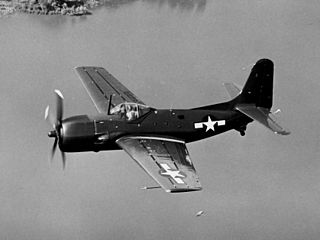 W
WThe Curtiss XBT2C was a prototype two-seat, single-engined dive/torpedo bomber developed during World War II for the United States Navy. Derived from the Curtiss SB2C Helldiver dive bomber, it was an unsuccessful competitor to meet a 1945 Navy specification for an aircraft to combine the roles that previously required separate types. Unlike the other competitors, the XBT2C was designed to accommodate a radar operator.
 W
WThe Curtiss SB2C Helldiver, also known as the A-25 Shrike, is a dive bomber developed by Curtiss-Wright during World War II. As a carrier-based bomber with the United States Navy (USN), in Pacific theaters, it supplemented and replaced the Douglas SBD Dauntless. A few survivors are extant.
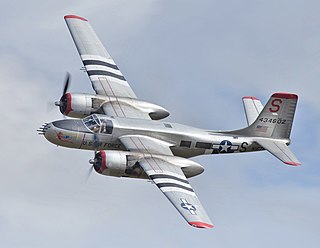 W
WThe Douglas A-26 Invader is an American twin-engined light bomber and ground attack aircraft. Built by Douglas Aircraft Company during World War II, the Invader also saw service during several major Cold War conflicts. A limited number of highly modified United States Air Force aircraft served in Southeast Asia until 1969. It was a fast aircraft capable of carrying a large bomb load. A range of guns could be fitted to produce a formidable ground-attack aircraft.
 W
WThe Douglas XB-19 was the largest bomber aircraft built for the United States Army Air Forces until 1946. It was originally given the designation XBLR-2.
 W
WThe Douglas XB-42 Mixmaster was an experimental bomber aircraft, designed for a high top speed. The unconventional approach was to mount the two engines within the fuselage driving a pair of contra-rotating propellers mounted at the tail in a pusher configuration, leaving the wing and fuselage clean and free of drag-inducing protrusions.
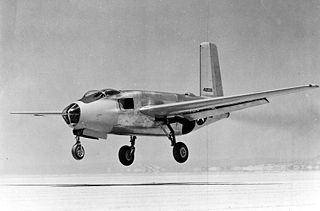 W
WThe Douglas XB-43 Jetmaster is an American 1940s jet-powered prototype bomber. The XB-43 was a development of the XB-42, replacing the piston engines of the XB-42 with two General Electric J35 engines of 4,000 lbf (17.8 kN) thrust each. Despite being the first American jet bomber to fly, it suffered stability issues and the design did not enter production.
 W
WThe Douglas BTD Destroyer is an American dive/torpedo bomber developed for the United States Navy during World War II. A small number had been delivered before the end of the war, but none saw combat.
 W
WThe Douglas SBD Dauntless is a World War II American naval scout plane and dive bomber that was manufactured by Douglas Aircraft from 1940 through 1944. The SBD was the United States Navy's main carrier-based scout/dive bomber from mid-1940 through mid-1944. The SBD was also flown by the United States Marine Corps, both from land air bases and aircraft carriers. The SBD is best remembered as the bomber that delivered the fatal blows to the Japanese carriers at the Battle of Midway in June 1942. The type earned its nickname "Slow But Deadly" during this period.
 W
WThe Douglas XTB2D Skypirate was a torpedo bomber intended for service with the United States Navy's Midway- and Essex-class aircraft carriers; it was too large for earlier decks. Two prototypes were completed, but the dedicated torpedo bomber was becoming an outdated concept, and with the end of World War II, the type was deemed unnecessary and cancelled.
 W
WThe Fairchild BQ-3, also known as the Model 79, was an early expendable unmanned aerial vehicle – referred to at the time as an "assault drone" – developed by Fairchild Aircraft from the company's AT-21 Gunner advanced trainer during the Second World War for use by the United States Army Air Forces. Two examples of the type were built and flight-tested, but the progress of guided missiles rendered the assault drone quickly obsolete, and the type was not produced.
 W
WThe Fleetwings BQ-1 was an early expendable unmanned aerial vehicle — referred to at the time as an "assault drone" — developed by Fleetwings during the Second World War for use by the United States Army Air Forces. Only a single example of the type was built, the program being cancelled following the crash of the prototype on its first flight.
 W
WThe Fleetwings BQ-2 was an early expendable unmanned aerial vehicle — referred to at the time as an "assault drone" — developed by Fleetwings during the Second World War for use by the United States Army Air Forces. Only a single example of the type was built; the aircraft was deemed too expensive for service and was cancelled after a brief flight testing career.
 W
WFlight 19 was the designation of a group of five General Motors Eastern Aircraft Division TBM Avenger torpedo bombers that disappeared over the Bermuda Triangle on December 5, 1945, after losing contact during a United States Navy overwater navigation training flight from Naval Air Station Fort Lauderdale, Florida. All 14 airmen on the flight were lost, as were all 13 crew members of a Martin PBM Mariner flying boat that subsequently launched from Naval Air Station Banana River to search for Flight 19. A report by Navy investigators concluded that flight leader Lt. Charles C. Taylor mistook small islands offshore for the Florida Keys after his compasses stopped working, resulting in the flight heading over open sea and away from land. The report was later amended by the Navy to read "cause unknown" to avoid blaming Taylor for the loss of 5 aircraft and 14 men. The report attributed the loss of the PBM aircraft to an explosion in mid-air while searching for the flight.
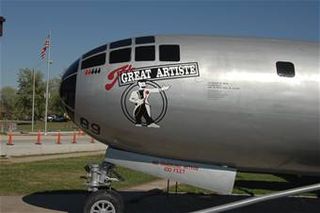 W
WThe Great Artiste was a U.S. Army Air Forces Silverplate B-29 bomber, assigned to the 393d Bomb Squadron, 509th Composite Group. The aircraft was named for its bombardier, Captain Kermit Beahan, in reference to his bombing talents. It flew 12 training and practice missions in which it bombed Japanese-held Pacific islands and dropped pumpkin bombs on targets in Japan. It was the only aircraft to participate in both the bombings of Hiroshima and Nagasaki, albeit as an observation aircraft on each mission.
 W
WThe Grumman TBF Avenger is an American torpedo bomber developed initially for the United States Navy and Marine Corps, and eventually used by several air and naval aviation services around the world.
 W
WThe Interstate TDR was an early unmanned combat aerial vehicle — referred to at the time as an "assault drone" — developed by the Interstate Aircraft and Engineering Corporation during the Second World War for use by the United States Navy. Capable of being armed with bombs or torpedoes, 2000 aircraft were ordered, but only around 200 were built. The type saw some service in the Pacific Theater against the Japanese, but continuing developmental issues affecting the aircraft, along with the success of operations using more conventional weapons, led to the decision being made to cancel the assault drone program in October 1944.
 W
WThe Kaiser-Fleetwings XBTK was a dive and torpedo bomber developed for the United States Navy starting in 1944. After only five examples had been built, with the first two being flying prototypes; the contract was terminated in September 1946.
 W
WThe Lockheed Ventura is a twin-engine medium bomber and patrol bomber of World War II.
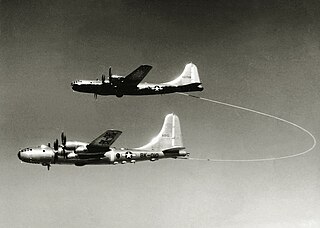 W
WLucky Lady II is a United States Air Force Boeing B-50 Superfortress that became the first airplane to circle the world nonstop. Its 1949 journey, assisted by in-flight refueling, lasted 94 hours and 1 minute. The plane later suffered an accident, and today only the fuselage is preserved.
 W
WThe Martin B-26 Marauder is an American twin-engined medium bomber that saw extensive service during World War II. The B-26 was built at two locations: Baltimore, Maryland, and Omaha, Nebraska, by the Glenn L. Martin Company.
 W
WThe Martin XB-48 was an American medium jet bomber developed in the mid-1940s. It competed with the Boeing B-47 Stratojet, which proved to be a superior design, and was largely considered as a backup plan in case the B-47 ran into development problems. It never saw production or active duty, and only two prototypes, serial numbers 45-59585 and 45-59586, were built.
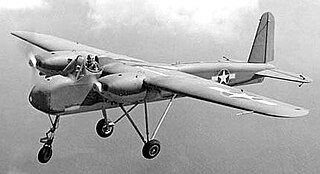 W
WThe Naval Aircraft Factory TDN was an early unmanned combat aerial vehicle - referred to at the time as an "assault drone" - developed by the United States Navy's Naval Aircraft Factory during the Second World War. Developed and tested during 1942 and 1943, the design proved moderately successful, but development of improved drones saw the TDN-1 relegated to second-line duties, and none were used in operational service.
 W
WThe North American B-25 Mitchell is an American medium bomber that was introduced in 1941 and named in honor of Major General William "Billy" Mitchell, a pioneer of U.S. military aviation. Used by many Allied air forces, the B-25 served in every theater of World War II, and after the war ended, many remained in service, operating across four decades. Produced in numerous variants, nearly 10,000 B-25s were built. These included several limited models such as the F-10 reconnaissance aircraft, the AT-24 crew trainers, and the United States Marine Corps' PBJ-1 patrol bomber.
 W
WThe North American XB-28 (NA-63) Dragon was an aircraft proposed by North American Aviation to fill a strong need in the United States Army Air Corps for a high-altitude medium bomber. It never entered production, with only two prototypes being built.
 W
WThe North American B-45 Tornado was an early American jet-powered bomber designed and manufactured by aircraft company North American Aviation. It has the distinction of being the first operational jet bomber to enter service with the United States Air Force (USAF), as well as being the first multiengine jet bomber in the world to be refueled in midair.
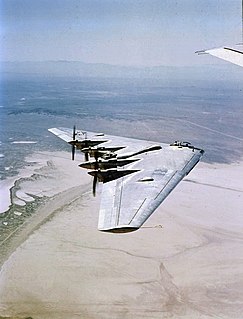 W
WThe Northrop XB-35 and YB-35, Northrop designation N-9 or NS-9, were experimental heavy bomber aircraft developed by the Northrop Corporation for the United States Army Air Forces during and shortly after World War II. The airplane used the radical and potentially very efficient flying wing design, in which the tail section and fuselage are eliminated and all payload is carried in a thick wing. Only prototypes and pre-production aircraft were built, although interest remained strong enough to warrant further development of the design as a jet bomber, under the designation YB-49.
 W
WThe Northrop YB-49 was an American prototype jet-powered heavy bomber developed by Northrop Corporation shortly after World War II for service with the United States Air Force. The YB-49 featured a flying wing design and was a turbojet-powered development of the earlier, piston-engined Northrop XB-35 and YB-35. The two YB-49s actually built were both converted YB-35 test aircraft.
 W
WThe Piper LBP was a glide bomb, or "Glomb", developed by Piper Aircraft for the United States Navy during World War II. Developed as one of three "Glomb" aircraft, the inherent limitations of the Glomb and the technology of the time, combined with difficulties encountered in testing of the prototype, led to the production contract for the LBP-1 being reduced, then cancelled, with none of the Glomb aircraft ever seeing operational service.
 W
WThe Pratt-Read LBE-1 was a prototype glide bomb, or "Glomb", developed for the United States Navy during World War II. Although there were high hopes for the concept, the limitations of the Glomb led to the production contract for the LBE-1 being reduced, then cancelled, and only four examples of the type were ever built.
 W
WRaisin Bombers was the colloquial name given by Berliners to the Western Allied transport aircraft which brought in supplies by airlift to West Berlin during the Soviet Berlin Blockade in 1948/1949. In US English they were called Candy Bombers.
 W
WThe Taylorcraft LBT was a glider designed and built by Taylorcraft during World War II, in response to a United States Navy requirement for a glide bomb. One of three prototype "Glomb" models ordered by the Navy, the LBT suffered from technical and performance difficulties, and was cancelled early in production, none of the aircraft seeing operational service.
 W
W